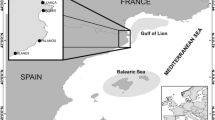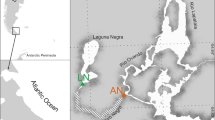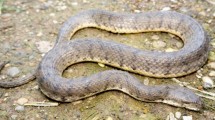Abstract
In reptiles, many lipid reserve structures were recognized, and different patterns of storage and utilization of lipids have been identified. In this study, a population of Liolaemus koslowskyi was studied to analyze the diversity and functioning of the lipid reserve structures. The specific objectives were to identify the main lipid reserve structures, and to describe their seasonal patterns; to study sexual and seasonal variations of the reserve structures; and to analyze the relation between seasonal patterns of such reserves with the sexual cycle and other biological aspects. Individuals of both sexes collected at five different times of the year were analyzed. The abdominal fat bodies, livers, tails, fat deposits of the lateral folds of the neck, the fat bodies of the axillary region and gonads were weighted. The fat content of livers, tails and neck fat reserves were determined through the extraction in a Soxhlet device. The volume of the ovaries, oviductal oocytes and testicles, and the average surface and thickness of the epididymides were estimated. The abdominal fat bodies and the tail-extracted fats were the main lipid reserves. In general, females showed higher lipid contents, and significant seasonal variations in weight and lipid content in both sex were found, while seasonal variations in the liver fresh weight and liver fat content were found only in males. The axillar and neck fats deposits probably function as auxiliary reserves, and the caudal autotomy did not significantly affect tail fat content. The sexual cycles were synchronic in both sexes.







Similar content being viewed by others
References
Abdala CS (2007) Phylogeny of the boulengeri group (Iguania: Liolaemidae, Liolaemus) based on morphological and molecular characters. Zootaxa 1538:1–84
Abràmoff MD, Magalhães PJ, Ram SJ (2004) Image processing with ImageJ. Biophotonics international 11:36–42
Arnold NE (1984) Evolutionary aspects of tail shedding in lizards and their relatives. J Nat Hist 18:127–169
Aun L, Martori R (1998) Reproducción y dieta de Liolaemus koslowskyi Etheridge 1993. Cuad Herpetol 12:1–9
Avery R (1970) Utilization of caudal fat by hibernating common lizards, Lacerta vivipara. Comp Biochem Physiol 37:119–121
Benabib M (1994) Reproduction and lipid utilization of tropical populations of Sceloporus variabilis. Herpetol Monogr 8:160–180
Cabrera A, Willink A (1980) Biogeografía de América Latina. Secretaría General de la Organización de los Estados Americanos (OEA). Programa Regional de Desarrollo Científico y Tecnológico, Washington
Daniels CB (1984) The importance of caudal lipid in the gecko Phyllodactylus marmoratus. Herpetologica 40:337–344
Daniels CB (1985) Economy of autotomy as a lipid conserving mechanism: an hypothesis rejected for the gecko Phyllodactylus marmoratus. Copeia 1985:468–472
Derickson WK (1976) Lipid storage and utilization in reptiles. Am Zool 16:711–723
Di Rienzo JA, Casanoves F, Balzarini MG, González L, Tablada M, Robledo CW (2015) InfoStat (versión 2015). Grupo InfoStat, Universidad Nacional de Córdoba, Argentina. http://www.infostat.com.ar
Doughty P, Shine R, Lee M (2003) Energetic costs of tail loss in a montane scincid lizard. Comp Biochem Physiol A 135:215–219
Etheridge R (1993) Lizards of the Liolaemus darwinii complex (Squamata: Iguania: Tropiduridae) in northern Argentina. Boll Mus Reg Sci Nat Torino 11:137–199
Fernández JB, Medina M, Kubisch EL, Manero AA, Scolaro JA, Ibargüengoytía NR (2015) Female reproductive biology of the lizards Liolaemus sarmientoi and L. magellanicus from the southern end of the world. Herpetol J 25:101–108
Fox SF, Shipman PA (2003) Social behavior at high and low elevations: environmental release and phylogenetic effects in Liolaemus. In: Fox SF, McCoy JK, Baird TA (eds) Lizard social behavior. Johns Hopkins University Press, Baltimore, pp 310–355
Gaffney FG, Fitzpatrick LC (1973) Energetics and lipid cycles in the lizard, Cnemidophorus tigris. Copeia 1973:446–452
Goldberg SR (1972) Seasonal weight and cytological changes in the fat bodies and liver of the iguanid lizard Sceloporus jarrovi Cope. Copeia 1972:227–232
Guillette LJ Jr, Sullivan WP (1985) The reproductive and fat body cycles of the lizard, Sceloporus formosus. J Herpetol 19:474–480
Hahn WE (1967) Estradiol-induced vitellinogenesis and concomitant fat mobilization in the lizard Uta stansburiana. Comp Biochem Physiol 23:83–93
Hahn WE, Tinkle DW (1965) Fat body cycling and experimental evidence for its adaptive significance to ovarian follicle development in the lizard Uta stansburiana. J Exp Zool A Ecol Genet Physiol 158:79–85
Halloy MC (1996) Behavioral patterns in Liolaemus quilmes (Tropiduridae), a South American lizard. Bull Md Herpetol Soc 32:43–57
Halloy M, Robles C, Salica MJ, Semhan R, Juárez Heredia V, Vicente N (2013) Estudios de comportamiento y ecología de lagartijas de los géneros Liolaemus y Phymaturus (Iguania: Liolaemini). Cuad Herpetol 27:15–26
Hamann M, Limpus C, Whittier J (2002) Patterns of lipid storage and mobilisation in the female green sea turtle (Chelonia mydas). J Comp Physiol B Biochem Syst Environ Physiol 172:485–493
Ho SM, Kleis S, McPherson R, Heisermann GJ, Callard IP (1982) Regulation of vitellogenesis in reptiles. Herpetologica 38:40–50
Ibargüengoytía NR, Cussac VE (1999) Male response to low frequency of female reproduction in the viviparous lizard Liolaemus (Tropiduridae). Herpetol J 9:111–117
Ji X, Wang P (1990) Annual cycles of lipid contents and caloric values of carcass and some organs of the gecko, Gekko japonicus. Comp Biochem Physiol A: Mol Integr Physiol 96:267–271
Kottek M, Grieser J, Beck C, Rudolf B, Rubel F (2006) World Map of the Köppen–Geiger climate classification updated. Meteorol Z 15:259–263
Kwan D (1994) Fat reserves and reproduction in the green turtle, Chelonia mydas. Wildlife Res 21:257–265
Labra A, Carazo P, Desfilis E, Font E (2007) Agonistic interactions in a Liolaemus lizard: structure of head bob displays. Herpetologica 63:11–18
Licht P, Gorman GC (1970) Reproductive and fat cycles in Caribbean Anolis lizards. Univ Calif Publ Zool 95:1–52
Lin Z-H, Ji X (2005) Partial tail loss has no severe effects on energy stores and locomotor performance in a lacertid lizard, Takydromus septentrionalis. J Comp Physiol B 175:567–573
Martori R, Aun L (1997) Reproductive and fat body cycle of Liolaemus wiegmannii in Central Argentina. J Herpetol 31:578–581
Martori R, Aun L (2010) Reproducción y variación de grupos de tamaño en una población de Liolaemus koslowskyi (Squamata: Liolaemini). Cuad Herpetol 24:39–55
Martori R, Aun L, Orlandini S (2002) Relaciones térmicas temporales en una población de Liolaemus koslowskyi. Cuad Herpetol 16:33–45
Medel RG (1992) Costs and benefits of tail loss: assessing economy of autotomy in two lizard species of central Chile. Rev Chil Hist Nat 65:357–361
Medina M, Ibargüengoytía N (2010) How do viviparous and oviparous lizards reproduce in Patagonia? A comparative study of three species of Liolaemus. J Arid Environ 74:1024–1032
Pianka ER (1970) Comparative autecology of the lizard Cnemidophorus tigris in different parts of its georgraphic range. Ecology 51:703–720
R Development Core Team (2015) R: A language and environment for statistical computing (version 3.2.0). R Foundation for Statistical Computing, Vienna. http://www.R-project.org
Ramírez-Bautista A, Vitt LJ (1997) Reproduction in the lizard Anolis nebulosus (Polychrotidae) from the Pacific coast of Mexico. Herpetologica 53:423–431
Ramírez-Bautista A, García-Collazo R, Guillette LJ Jr, Carpenter GC (2006) Reproductive, fat, and liver cycles of male and female rose-bellied lizards, Sceloporus variabilis, from coastal areas of southern Veracruz, Mexico. Southwest Nat 51:163–171
Ramírez-Pinilla MP (1989) Ciclo reproductivo y de cuerpos grasos de una población ovípara de Liolaemus alticolor. Bol Asoc Herp Arg 5:6–7
Ramírez-Pinilla MP (1991a) Estudio histológico de los tractos reproductivos y actividad cíclica anual reproductiva de machos y hembras de dos especies del género Liolaemus (Reptilia: Sauria: Iguanidae). Ph.D. Thesis Dissertation, Universidad Nacional de Tucumán
Ramírez-Pinilla MP (1991b) Reproductive and fat body cycle of the lizard Liolaemus wiegmanni. Amph Reptilia 12:195–202
Ramírez-Pinilla MP (1991c) Reproductive and fat body cycles of the viviparous lizard Liolaemus huacahuasicus. J Herpetol 25:205–208
Ramírez-Pinilla MP (1992) Ciclos reproductivos y de cuerpos grasos en dos poblaciones de Liolaemus darwinii (Reptilia: Sauria: Tropiduridae). Act Zool Lill 42:41–49
Ramírez-Pinilla MP (1994) Reproductive and fat body cycles of the oviparous lizard Liolaemus scapularis. J Herpetol 28:521–524
Ramírez-Pinilla MP (1995) Reproductive and fat body cycles of the oviparous lizard Liolaemus bitaeniatus (Sauria: Tropiduridae). J Herpetol 29:256–260
Rocha CFD (1992) Reproductive and fat body cycles of the tropical sand lizard (Liolaemus lutzae) of southeastern Brazil. J Herpetol 26:17–23
Sandoval FMR, Rodríguez-Tobón A, León-Galván MA, Méndez de la Cruz F, Arenas Ríos E (2014) Fisiología reproductiva de la lagartija macho Sceloporus mucronatus. ReIbCi 1:121–128
Selcer KW (1987) Seasonal variation in fatbody and liver mass of the introduced Mediterranean gecko, Hemidactylus turcicus, in Texas. J Herpetol 21:74–78
Semhan RV (2015) Análisis comparativo de ensambles de lagartos del género Liolaemus: factores ecológicos y limitantes históricos. Ph.D. Thesis Dissertation, Universidad Nacional de Tucumán
Telford SR (1970) Seasonal fluctuations in liver and fat body weights of the japanese lacertid Takydromus tachydromoides Schlegel. Copeia 1970:681–689
Thompson M, Speake B (2004) Egg morphology and composition. In: Deeming DC (ed) Reptilian incubation: environment, evolution and behaviour. Nottingham University Press, Nottingham, pp 45–74
Uetz P, Freed P, Hošek J (2019) The reptile database. http://www.reptile-database.org. Accessed 8 May 2019
Valdecantos MS, Lobo F (2007) Dimorfismo sexual en Liolaemus multicolor y L. irregularis (Iguania: Liolaemidae). Rev Esp Herp 21:55–69
Verrastro L (2004) Sexual dimorphism in Liolaemus occipitalis (Iguania: Tropiduridae). Iheringia Sér Zool 94:45–48
Verrastro L, Rauber R (2013) Reproducción de las hembras de Liolaemus occipitalis boulenger, 1885, (Iguania, Liolaemidae) en la región sur de Brasil. Bol Soc Zool Urug 22:84–98
Villavicencio HJ, Acosta JC, Cánovas MG, Marinero JA (2003) Dimorfismo sexual de Liolaemus pseudoanomalus (Iguania: Liolaemidae) en el centro-oeste de Argentina. Rev Esp Herp 17:87–92
Vitt LJ, Zani PA (2005) Ecology and reproduction of Anolis capito in rain forest of southeastern Nicaragua. J Herpetol 39:36–42
Whittier J, Mason R (1996) Plasma triglyceride and β-hydroxybutyric acid levels in red-sided garter snakes (Thamnophis sirtalis parietalis) at emergence from hibernation. Cell Mol Life Sci 52:145–148
Zuur AF, Ieno EN, Elphick CS (2010) A protocol for data exploration to avoid common statistical problems. Meth Ecol Evol 1:3–14
Acknowledgements
We especially thank Carlos Paz for all the support brought during the development of this study. To the Cátedra de Cereales y Forrajes of Facultad de Agronomía y Zootecnia, Universidad Nacional de Tucumán, Tucumán, Argentina, for allowing us to use their facilities when carrying out the laboratory analyses. To Mario Ruiz Monachesi and to the Abdala family for their support during fieldwork. To Segundo Nuñez-Campero, for his hospitality and support during the 2013 field trip. To Julio Maidana for his assessment in the laboratory analysis. To Ana Sofia Nanni for the translation of the manuscript and critical review. We thank Shai Meiri and an anonymous reviewer for their constructive criticisms and suggestions that have been of great help for the improvement of the manuscript. This research was made possible through the funding of the Consejo Nacional de Investigaciones Científicas y Técnicas (CONICET), and the financial support of Esteban Lavilla, from the Instituto de Herpetología de la Fundación Miguel Lillo, Tucumán, Argentina; and Pablo Chafrat and David Camino, from the Museo Patagónico de Ciencias Naturales “Juan Carlos Salgado”, Río Negro, Argentina. Part of these studies were carried out with the support of the Projects PIP 2422; PIP 0303; PICT 2263 and PICT 1398.
Author information
Authors and Affiliations
Corresponding author
Additional information
Communicated by N. Kronfeld-Schor.
Publisher's Note
Springer Nature remains neutral with regard to jurisdictional claims in published maps and institutional affiliations.
Rights and permissions
About this article
Cite this article
Paz, M.M., García, N.E., Semhan, R.V. et al. Study of lipid reserves in Liolaemus koslowskyi (Squamata: Liolaemidae): reproductive and ecological implications. J Comp Physiol B 189, 595–609 (2019). https://doi.org/10.1007/s00360-019-01226-8
Received:
Revised:
Accepted:
Published:
Issue Date:
DOI: https://doi.org/10.1007/s00360-019-01226-8




